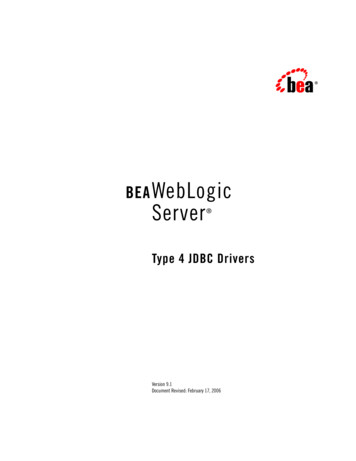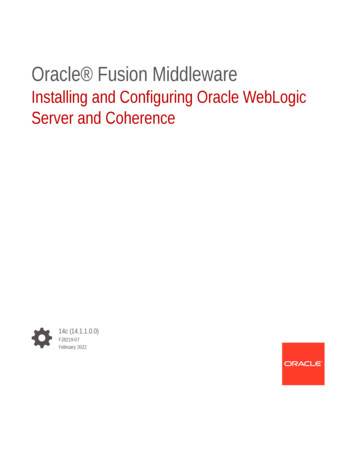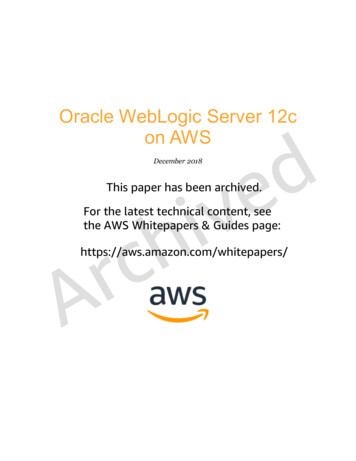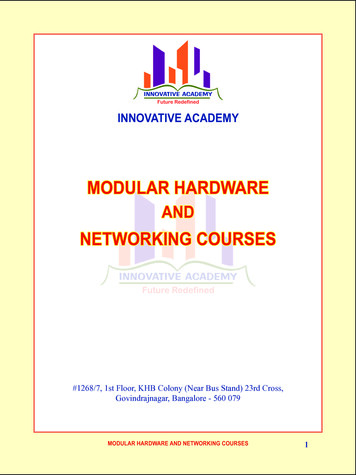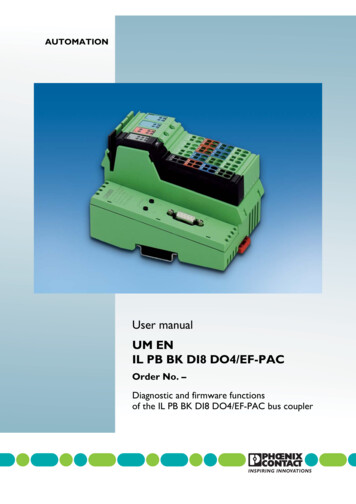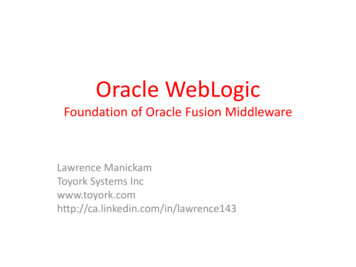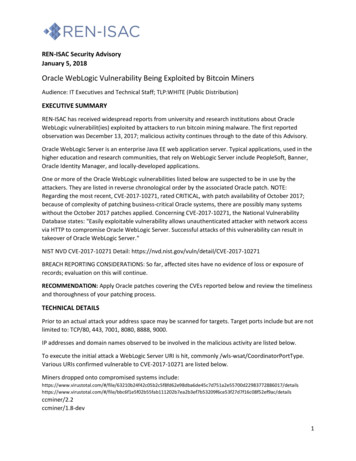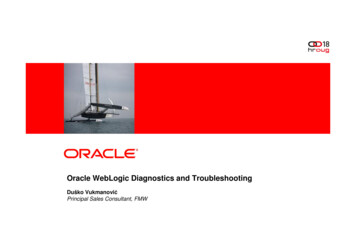
Transcription
Insert Picture Here Oracle WebLogic Diagnostics and TroubleshootingDuško VukmanovićPrincipal Sales Consultant, FMW
What is the WebLogic Diagnostic Framework? A framework for diagnosing problems that happen at runtime in a WebLogicServer environment and in the applications that are deployed on the server(s) Provides a watch/notification system with many options for defining conditions towatch for Provides pointcut weaving for advanced code instrumentation andtroubleshooting Enables you to dump a diagnostic image to disk and capture a large set ofruntime data from WebLogic, JRockit and your applications Integrates with JRockit Flight Recorder to capture WebLogic Events for offline orafter-the-fact viewing
Overview of the WebLogic Diagnostics FrameworkPullLog File Event Collector WLST API JMX APIAccessor WLDF DashboardArchiverMBean PropertyHarvester SNMP TrapWatcherPushNotifier JMS Message JMX Notification SMTP EmailCode Instrumentor Diagnostic ImageJRockit Flight RecorderBufferCaptureProcessJRockitMission ControlExposeRetrieve
WLDF ComponentsConfiguring and Using the WebLogic Diagnostic Framework Server-Level Configuration (domain config.xml)– Diagnostic Image Capture– Diagnostic Archives The following WLDF components are configured as Diagnostic SystemModules, or resources, that can be deployed to server instances:– Harvester (for collecting metrics)– Watches and Notifications– Instrumentation Application-Level Configuration– The WLDF Instrumentation component can be used with applications– The Instrumentation component is configured in a resource descriptor file deployed withthe application in the applications archive file
But, why should I care? This will allow you to monitor and notify on WebLogic internalmetrics that may be causing problems. Common examplesinclude JDBC connection pool metrics like:– Average/Max Connection Pool Wait Time– Average/Max Number In Use– Prepared Statement Cache Hit/Miss Ratio JMS Server Metrics like:– Number of Messages– Number of consumers 1
Configuring Diagnostic System Modules
Diagnostic System Module OverviewConfiguring Diagnostic System Modules A Diagnostic System Module (DSM) is a configuration container for one ormore of the following:– Harvester - for collecting metrics from MBeans– Watches and Notifications – conditions to watch for and the notification action to take– Instrumentation - The Instrumentation component of the WebLogic DiagnosticFramework (WLDF) provides a mechanism for adding diagnostic code to WebLogicServer instances and the applications running on them You create a diagnostic system module through the Administration Console orthe WebLogic Scripting Tool (WLST) DSM’s are globally available for targeting servers and clusters and can betargeted to multiple servers and clusters
WLDF Configuration MBeansEnables you to view & edit theconfiguration information usingJMX, WLST
Managing Diagnostic System Modules A DSM can be targeted to zero, one, or more servers, although a given server can haveonly one module targeted to it at a time. You can create multiple DSM’s that monitor different aspects of your system and thenchoose which module to target to a server or cluster, based on what you want to monitor atthat time. Because you can target the same module to multiple servers or clusters, you can writegeneral purpose modules that you want to use across a domain. You can change the target of a diagnostic module without restarting the server instance(s)to which it is targeted or untargeted. This gives you considerable flexibility in writing and using diagnostic monitors that addressa specific diagnostic goal, without interfering with the operation of the server instancesthemselves.
The Harvester
Harvester – Configuring and ManagingDiagnostic System Module Components Data must meet certain requirements in order to be harvestable, and it mustmeet further requirements in order to be harvested: Harvestable data is data that can potentially be harvested from harvestableentities, including MBean types, instances, and attributes. To be harvestable,an MBean must be registered in the local WebLogic Server runtime MBeanserver. Only simple type attributes of an MBean can be harvestable. Harvested data is data that is currently being harvested. To be harvested, thedata must meet all the following criteria:– The data must be harvestable and configured to be harvested.– For custom MBeans, the MBean must be currently registered with the server– The data must not throw exceptions while being harvested.
Harvesting MBean MetricsConfiguring Diagnostic System Modules The Harvester is used to collect data from harvestable entities, includingMBean types, instances, and attributes Only simple type attributes of an MBean can be harvested To be harvestable, an MBean must be registered in the local WebLogicServer runtime MBean server Data Types––––A Type (only)An Attribute of a Type (Type Attributes)An Instance of a Type (Type Instances)An Attribute of an Instance of a Type (Type Instances Attributes) Sampling Period
Configuring the Sampling PeriodConfiguring the Harvester The sample-period element sets the sample period for the Harvester The sample period specifies the time between each cycle.– For example, if the Harvester begins execution at time T, and the sample period is I, thenthe next harvest cycle begins at T I. If a cycle takes A seconds to complete and ifA exceeds I, then the next cycle begins at T A. If this occurs, the Harvester tries to startthe next cycle sooner, to ensure that the average interval is I.
Harvesting a TypeConfiguring the Harvester The sample-period element sets the sample period for the Harvester The sample period specifies the time between each cycle, from the start of the cycle to the start ofthe next cycle. If a cycle takes longer than the sample-period, the next cycle will start as soon as thecurrent cycle is complete If no harvested-instance is present, all instances that are present at the time of each harvest cycleare collected.
Harvesting an Attribute of a TypeConfiguring the Harvester The optional harvested-attribute element specifies that metrics are to be collected only for the listedattributes of the specified type. An attribute is specified by providing its name. The first character should becapitalized. For example, an attribute defined with getter method getFoo() is named Foo The harvested-attribute element also supports an expression syntax for “drilling down” into attributes thatare complex or aggregate objects, such as lists, maps, simple POJOs (Plain Old Java Objects), and variousnestings of these types If no harvested-attribute is present, all harvestable attributes defined for the type are collected
Watches & Notifications
Watches & NotificationsConfiguring Diagnostic System Modules A Watch identifies a situation that you want to trap for monitoring or diagnostic purposes. You canconfigure three types of watches:– Harvester - monitor the set of harvestable MBeans in the local runtime MBean server.– Log - monitor the set of messages generated into the server log.– Instrumentation (or Event Data) monitor the set of events generated by the WLDF Instrumentation component. A Notification is an action that is taken when a watch rule expression evaluates to true. WLDF supportsthe following types of notifications–SMTP Notification – Allows you to send a notification via e-mail using an SMTP Session–JMX Notification – Allows you to raise a JMX notification on the server’s WLDFWatchJMXNotificationRuntimeMBean–JMS Notification – Allows you to send a JMS message to a Queue or Topic–SNMP Notification – Allows you to raise an SNMP trap on the server–Image Notification – Allows you to dump a diagnostic image to disk
Options for All Types of WatchesConfiguring Diagnostic System Modules Watch Rule Expression - a logical expression that specifies what significantevents the watch is to trap Notifications for Watch - Each watch can be associated with one or morenotifications that are triggered whenever the watch evaluates to true Alarm Options - Watches can be specified to trigger repeatedly, or to triggeronce, when a condition is met. For watches that trigger repeatedly, you canoptionally define a minimum time between occurrences Severity Options - Watches contain a severity value which is passed throughto the recipients of notifications Enabled Options - Each watch can be individually enabled and disabled,using the sub-element enabled .
Configuring Harvester Watches A Harvester watch can monitor anyruntime MBean in the local runtimeMBean server Harvester watches are triggered inresponse to a harvest cycle Harvesting does not have to beconfigured and enabled for harvesterwatches However, configuring the Harvestercan provide advantages - for examplethe data will be archived and can beviewed offline leading up to the watchbeing triggered
Configuring Log Watches Use Log watches to monitor theoccurrence of specific messages and/orstrings in the server log. Watches of this type are triggered as aresult of a log message containing thespecified data being issued– log-watch-severity specifies thethreshold severity for a log watch to beevaluated further– You can use rule-expression to filter for specific errorcodes or conditions
Configuring Notifications
Configuring SMTP NotificationsConfiguring Notifications Simple Mail Transfer Protocol (SMTP) notifications are used to send messages (e-mail) over the SMTPprotocol in response to the triggering of an associated watch In order to use SMTP notifications, you must first configure the SMTP session for the domain An optional subject and/or body can be provided using sub-elements subject and body respectively. Ifthese are not provided, they will be defaulted.
Configuring JMX NotificationsConfiguring Notifications For each defined JMX notification, WLDF issues JMX events (notifications) wheneveran associated watch is triggered. Applications can register a notification listener with the server’sWLDFWatchJMXNotificationRuntimeMBeans to receive all notifications and filter theprovided output. You can also specify a JMX “notification type” string that a JMX client can use as a filter
Configuring JMS NotificationsConfiguring Notifications JMS Notifications can be sent to either a Queue or Topic You must specify the Connection Factory and Destination JNDI Names For this to work properly you must have a valid JMS configuration for thetargets where the DMS is deployed
Diagnostic Images
Diagnostic Image Capture & ArchivesConfiguring and Using the WebLogic Diagnostic Framework Diagnostic Image Capture - Creates a diagnostic snapshot from the server that canbe used for post-failure analysis. Diagnostic Archive - Captures and persists data events, log records, and metrics fromserver instances and applications
Diagnostic Image Information CapturedConfiguring and Using the WebLogic Diagnostic Framework An image is captured as a single file for the entire server. Each imagehas a unique name, as follows:– diagnostic image domain server yyyy MM dd HH mm ss The most common sources of a server state are captured in a diagnosticimage capture, including:––––––ConfigurationLog cache stateJava Virtual Machine (JVM)Work manager stateJNDI stateHarvestable data
Configuring Image NotificationsConfiguring Notifications An image notification causes a diagnostic image to be generated in response to the triggeringof an associated watch. Configuration:– The directory name relative to the Server directory where images will be generated,– Image file names are generated using the current timestamp - forexample, diagnostic image myserver 2005 08 09 13 40 34.zip– The lockout period determines the number of seconds that must elapse before a new image can begenerated after the last one.
D E M O N S T R A T I O N
Questions?
Configuring SMTP Notifications Simple Mail Transfer Protocol (SMTP) notifications are used to send messages (e-mail) over the SMTP protocol in response to the triggering of an associated watch In order to use SMTP notifications, you must first configure the SMTP session for the domain
